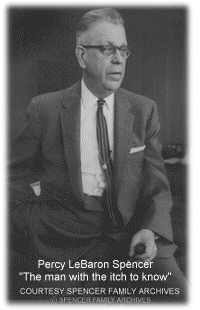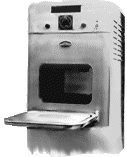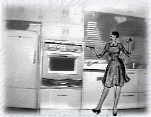Microwave Oven History
The next morning, Scientist
Spencer decided Dr. Spencer fashioned a metal box
with an opening into which he fed microwave power. The energy entering the
box was unable to escape, thereby creating a higher density
electromagnetic field. When food was placed in the box and microwave
energy fed in, the temperature of the food rose very rapidly. Dr. Spencer
had invented what was to revolutionize cooking, and form the basis of a
multimillion dollar industry, the microwave oven. The microwave oven had reached a
new level of acceptance, particularly with regard to certain industrial
applications. By having a microwave oven available, restaurants and
vending companies could now keep products refrigerator-fresh up to the
point of service, then heat to order. The result? Fresher food, less
waste, and money saved. By 1975, sales of microwave ovens
would, for the first time, exceed that of gas ranges. The following year,
a reported 17% of all homes in Japan were doing their cooking by
microwaves, compared with 4% of the homes in the United States the same
year. Before long, though, microwave ovens were adorning the kitchens in
over nine million homes, or about 14%, of all the homes in the United
States. In 1976, the microwave oven became a more commonly owned kitchen
appliance than the dishwasher, reaching nearly 60%, or about 52 million
U.S. households. America's cooking habits were being drastically changed
by the time and energy-saving convenience of the microwave oven. Once
considered a luxury, the microwave oven had developed into a practical
necessity for a fast-paced world.
An expanding market has produced
a style to suit every taste; a size, shape, and color to fit any kitchen,
and a price to please almost every pocketbook. Options and features, such
as the addition of convection heat, probe and sensor cooking, meet the
needs of virtually every cooking, heating or drying application. Today,
the magic of microwave cooking has radiated around the globe, becoming an
international phenomenon. On September 18, 1999, Dr. Percy LaBaron Spencer was
inducted into the National Inventors Hall of Fame and took his place in
history alongside such great inventors as Thomas Edison, the Wright
Brothers and George Washington Carver.
Note: Photo of Percy
Spencer and Patent provided courtesy of The Spencer Family Archives to
put the magnetron tube near an egg. Spencer was joined by a curious
colleague, and they both watched as the egg began to tremor and quake. The
rapid temperature rise within the egg was causing tremendous internal
pressure. Evidently the curious colleague moved in for a closer look just
as the egg exploded and splattered hot yoke all over his amazed face. The
face of Spencer lit up with a logical scientific conclusion: the melted
candy bar, the popcorn, and now the exploding egg, were all attributable
to exposure to low-density microwave energy. Thus, if an egg can be cooked
that quickly, why not other foods? Experimentation began...
to
put the magnetron tube near an egg. Spencer was joined by a curious
colleague, and they both watched as the egg began to tremor and quake. The
rapid temperature rise within the egg was causing tremendous internal
pressure. Evidently the curious colleague moved in for a closer look just
as the egg exploded and splattered hot yoke all over his amazed face. The
face of Spencer lit up with a logical scientific conclusion: the melted
candy bar, the popcorn, and now the exploding egg, were all attributable
to exposure to low-density microwave energy. Thus, if an egg can be cooked
that quickly, why not other foods? Experimentation began...
Nearly 6 Feet Tall, Weighing 750 Pounds
Engineers went to work on
Spencer's hot new idea, developing and refining it for practical use. By
late 1946, the Raytheon Company had filed a patent proposing that
microwaves be used to cook food. An oven that heated food using microwave
energy was then placed in a Boston restaurant for testing. At last, in
1947, the first commercial microwave oven hit the market. T hese
primitive units where gigantic and enormously expensive, standing 5 1/2
feet tall, weighing over 750 pounds, and costing about $5000 each. The
magnetron tube had to be water-cooled, so plumbing installations were also
required.
hese
primitive units where gigantic and enormously expensive, standing 5 1/2
feet tall, weighing over 750 pounds, and costing about $5000 each. The
magnetron tube had to be water-cooled, so plumbing installations were also
required.
Initial Reactions Were
Unfavorable
Not surprisingly, many were highly
reluctant about these first units, and so they found only limited
acceptance. Initial sales were disappointing...but not for long. Further
improvements and refinements soon produced a more reliable and lightweight
oven that was not only less expensive, but, with the development of a new
air-cooled magnetron, there was no longer any need for a plumber.
New and Unusual Applications
As the food industry began to
recognize the potential and versatility of the microwave oven, its
usefulness was put to new tests. Industries began using microwaves to dry
potato chips and roast coffee beans and peanuts. Meats could be defrosted,
precooked and tempered. Even the shucking of oysters was made easier by
microwaves. Other industries found the diverse applications of microwave
heating quite advantageous. In time, microwaves were being used to dry
cork, ceramics, paper, leather, tobacco, textiles, pencils, flowers, wet
books and match heads. The microwave oven had become a necessity in the
commercial market and the possibilities seemed endless.
The
First "Radarange"
 In 1947, Raytheon demonstrated the world's first microwave
oven and called it a "Radarange," the winning name in an
employee contest. Housed in refrigerator-sized cabinets, the first
microwave ovens cost between $2,000 and $3,000. Sometime between 1952-55,
Tappan introduced the first home model priced at $1295. In 1965 Raytheon
acquired Amana Refrigeration. Two years later, the first countertop,
domestic oven was introduced. It was a 100-volt microwave oven, which cost
just under $500 and was smaller, safer and more reliable than previous
models.
In 1947, Raytheon demonstrated the world's first microwave
oven and called it a "Radarange," the winning name in an
employee contest. Housed in refrigerator-sized cabinets, the first
microwave ovens cost between $2,000 and $3,000. Sometime between 1952-55,
Tappan introduced the first home model priced at $1295. In 1965 Raytheon
acquired Amana Refrigeration. Two years later, the first countertop,
domestic oven was introduced. It was a 100-volt microwave oven, which cost
just under $500 and was smaller, safer and more reliable than previous
models.
By 1975 Sales of Microwave Ovens
Exceeded that of Gas Ranges
Technological advances and further developments led
to a microwave oven that was polished and priced for the consumer kitchen.
However, there were many myths and fears surrounding these mysterious new
electronic "radar ranges." By the seventies, more and more
people were finding the benefits of microwave cooking to outweigh the
possible risks, and none of them were dying of radiation poisoning, going
blind, sterile, or becoming impotent (at least not from using microwave
ovens). As fears faded, a swelling wave of acceptance began filtering into
the kitchens of America and other countries. Myths were melting away, and
doubt was turning into demand.
Inventor Spencer
Doctor Spencer continued at Raytheon
as a senior consultant until he died at the age of 76. At the time of his
death, Dr. Spencer held 150 patents and was considered one of the world's
leading experts in the field of microwave energy, despite his lack of a
high school education.
Picture of the earliest microwave oven provided courtesy of The Lemelson-MIT
Awards Program's Invention Dimension web site, http://web.mit.edu/invent

Copyrighted ©, 1989-2001 by J. Carlton Gallawa.